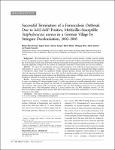Successful termination of a furunculosis outbreak due to lukS-lukF-positive, methicillin-susceptible Staphylococcus aureus in a German village by stringent decolonization, 2002-2005
Wiese-Posselt, Miriam
Heuck, Dagmar
Draeger, Andreas
Mielke, Martin
Witte, Wolfgang
Ammon, Andrea
Hamouda, Osamah
Background: Skin infections due to Staphylococcus aureus have recently become a public concern, mainly because of emerging resistance against widely used antibiotics and specific virulence determinants. Strains harboring the lukS-lukF gene (which codes for Panton-Valentine leukocidin) are frequently associated with severe furunculosis. Generally applicable strategies for the control of community outbreaks of furunculosis have not been defined. Methods: We report the investigation and successful termination of an outbreak of furunculosis due to lukS-lukF-positive S. aureus in a German village (n=144). Nasal swab specimens were obtained from village residents. A retrospective cohort study was conducted. Nasally colonized persons, persons who had current furuncles or who had experienced relapsing furuncles since 2002, and their family members underwent stringent decolonization measures using mupirocin nasal ointment and disinfecting wash solution. Multiple nasal swab specimens were obtained to monitor the long-term outcome of decolonization measures. Results: From January 1998 through December 2004, 42 cases and 59 relapses of furunculosis were identified by active case finding. Of 140 participants tested, 51 (36%) were found to be nasally colonized with S. aureus. In 9 participants, the strain was positive for lukS-lukF. No methicillin resistance was detected. Risk of furunculosis was associated with contact with case patients (relative risk, 6.8; 95% confidence interval, 3.2-14.3) and nasal colonization with a lukS-lukF-positive strain of S. aureus (relative risk, 3.6; 95% confidence interval, 2.3-5.9). Passive surveillance implemented in January 2005 did not detect any case of lukS-lukF-positive, S. aureus-associated furuncles in this village. Conclusion: This report describes a successful strategy for terminating the transmission of epidemic strains of S. aureus among a nonhospitalized population.
Dateien zu dieser Publikation
Keine Lizenzangabe

